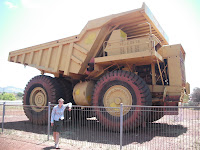
 Western Australia is big. Seriously big. The UK would fit into it between 20 and 26 times depending on who you believe. Since buying a car, I've covered over 6500km. To work out what that is in miles you can divide by 1.6. It's a long way, and there's still about a thousand miles to go before the border with the next state. Driving can be tiring due to the distances and the heat. The scenery mostly makes up for it though, even if it can be repetitive at times!
Western Australia is big. Seriously big. The UK would fit into it between 20 and 26 times depending on who you believe. Since buying a car, I've covered over 6500km. To work out what that is in miles you can divide by 1.6. It's a long way, and there's still about a thousand miles to go before the border with the next state. Driving can be tiring due to the distances and the heat. The scenery mostly makes up for it though, even if it can be repetitive at times! When not driving, I've done a lot of walking, and scrambled up some of the mountains on the way. This one is at Mount Bruce, the second highest mountain in WA. The rock is really red in this region, the Pilbara. A lot of mining happens, and like everything else, this is on a truly enormous scale.
When not driving, I've done a lot of walking, and scrambled up some of the mountains on the way. This one is at Mount Bruce, the second highest mountain in WA. The rock is really red in this region, the Pilbara. A lot of mining happens, and like everything else, this is on a truly enormous scale. This dump truck is one that used to be used at the mines. The wheels are 3.9m in diameter. That means they are taller than Mr Preece standing on Mr Wilson's shoulders. Maybe not an experiment we should try. They hold 4900 litres of diesel ( most cars are around 60 litres), and thousands of tonnes of rock, iron ore, shale or whatever you put in them!
The iron ore is put through a series of machinery to grade and mix it, and then carried by train to the coastal ports. Ore from this mine in a town called Tom Price goes to Dampier port. There are seven trains a day, each one is 2000m long with 200 trucks, carrying about 220000 tonnes of ore per train. In total over 200million tonnes left this mine last year. There are 12 mines just in this region, and many more than that all over WA, mining iron ore, copper, uranium, gold and many other minerals. If you are interested, there's lots of information on the web, and in particular the Rio Tinto (mining company) website. Many of the towns in this area including Tom Price) were built by the mining companies to house their
to house their
 to house their
to house their workers. They are often a long way from other towns, and in very hot areas, so can be quite tough living. I saw a great film about Dampier at the open cinema in Broome the other night. It's called Red Dog, and is essentially a feel good film about a pretty cute dog. There's great scenery of the Pilbara, and well worth a watch if it make it to the UK!
So what about the stuff that doesn't go on train? Well it still does. These big trucks are called Road Trains. It's not hard to see why. Road trains can be up to 53.5m long (over half a football pitch), and usually have 3 of the large trailers. They carry just about anything, groceries, building supplies, other vehicles (as you can see in the picture) all over the West Coast and through the centre of Australia. Road train drivers travel up to 1200-1300km every day, sleep in their trucks, then carry on the next day. This driver said "it's not a job, it's a lifestyle." He was on a trip from Perth (Western Australia) to Darwin (Northern Territories) - see if you can find out how far that is!
You can just see on the front of the truck that there's some large metal bars. These are 'roo bars. Kangaroos might be cute, but they are a major cause of accidents, either from cars hitting them, or swerving to avoid them, especially at dawn and dusk. These folk in the big trucks are ok, but in cars we never drive at night outside of towns to stay safe. It's important to plan journeys around sunset times (about 6pm at the moment) and be off the road before dark. Kangaroos are very impressive to watch, so it's much better to be somewhere nice by then! They evolved to hop for a very good reason. It can be a long way between food and water supplies in Australia, and hopping is very energy efficient for them - energy is stored in very long elastic tendons in their powerful legs (tendons join muscles and bones). This means they can travel long distances at speed when needed. Can you find out how a Kangaroo's top speed compares to some other animals?



No comments:
Post a Comment